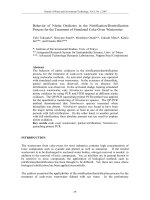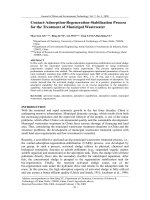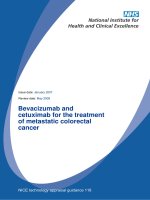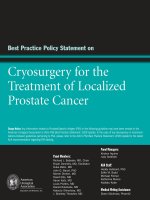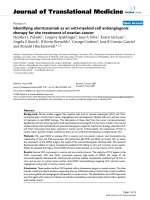Cultivated conjunctival epithelial transplantation for the treatment of ocular surface disease
Bạn đang xem bản rút gọn của tài liệu. Xem và tải ngay bản đầy đủ của tài liệu tại đây (9.45 MB, 176 trang )
i
CULTIVATED CONJUNCTIVAL
EPITHELIAL TRANSPLANTATION FOR
THE TREATMENT OF OCULAR
SURFACE DISEASE
LEONARD PEK-KIANG ANG
M.B.B.S. (Singapore), FRCS (Edinburgh),
MRCOphth (London), M.Med (Singapore)
A DISSERTATION SUBMITTED FOR THE DEGREE OF DOCTOR
OF MEDICINE
DEPARTMENT OF OPHTHALMOLOGY,
YONG LOO LIN SCHOOL OF MEDICINE
NATIONAL UNIVERSITY OF SINGAPORE
2004
ii
ACKNOWLEDGEMENTS
This dissertation would not have been possible without the help of the many
people who unselfishly gave their time and support.
Naturally, I relied heavily on the professional judgement of my supervisors, A/P
Donald Tan and Prof Roger Beuerman. I would like to express my deepest appreciation
and gratitude to my supervisors for their patient guidance and invaluable advice
throughout the course of this project.
I would also like to express my deepest appreciation to Dr Phan Toan Thang for
his advice and supervision in cell and tissue culture techniques and laboratory methods.
This project would also not be possible without the tremendous support and help from
Prof Robert Lavker, Prof Pamela Jensen, and Dr Barbara Risse, at the University of
Pennsylvania, USA, who taught me the various culture methods and laboratory
techniques that were required for this project.
My sincere gratitude also goes out to A/Prof Vivian Balakrishnan and A/Prof Ang
Chong Lye for their unwavering support and advice.
I would also like to thank Dr Howard Cajucom-Uy, Dr Jessica Abano, and
members of the Cornea team at the Singapore National Eye Centre who assisted in the
patient recruitment, management and follow-up of these patients. Sincere thanks to Dr
Wang Ziao Jing, Mr David Wong and Ms Cheyenne Seah from the Singapore Eye
Research Institute who assisted in the tissue culture and laboratory experiments.
Sincere thanks also go out to all the doctors and staff of the Singapore National
Eye Centre and the Singapore Eye Research Institute who contributed in any way to this
project.
I would also like to thank the various grant funding agencies that supported this
project: Singapore National Medical Research Council Grant R226/18/2001, Singapore
Biomedical Research Council Grant R268/12/2002 and Singapore Eye Research Institute
Grant R198/24/2000.
iii
CONTENTS
TITLE PAGE
ACKNOWLEDGEMENTS
TABLE OF CONTENTS
LIST OF FIGURES
LIST OF TABLES
ABBREVIATIONS
SUMMARY
LIST OF PUBLICATIONS
i
ii
iii
vii
ix
x
xi
xiii
CHAPTER 1: INTRODUCTION
CHAPTER 2: OCULAR SURFACE STEM CELL BIOLOGY AND
DISEASE TREATMENT
2.1 Introduction
2.2 Ocular surface stem cells
2.3 Identification of stem cells
2.4 Treatment of ocular surface stem cell deficiency
2.5 Ex vivo expansion of limbal stem cells for transplantation
2.6 Role of conjunctiva in maintaining the integrity of the ocular
surface
1
4
5
5
8
9
11
12
CHAPTER 3: AIMS
14
CHAPTER 4: SERIAL PROPAGATION OF HUMAN
CONJUNCTIVAL EPITHELIAL CELLS WITH SERUM-FREE
MEDIA
4.1 Introduction
4.2 Methods
4.2.1 Isolation and cultivation of human conjunctival
17
18
20
20
iv
epithelial cells
4.2.2 Quantitation of growth and proliferative capacity
4.2.3 Immunohistochemistry
4.2.4 RT-PCR of MUC5AC
4.3 Results
4.4 Discussion
CHAPTER 5: THE IN VIVO PROLIFERATIVE CAPACITY OF
SERUM-FREE CULTIVATED HUMAN CONJUNCTIVAL
EPITHELIAL CELLS
5.1 Introduction
5.2 Methods
5.2.1 Isolation and cultivation of human conjunctival
epithelial cells
5.2.2 Implantation into athymic mice
5.2.3 Histological and electron microscopic analysis of cysts
5.3 Results
5.4 Discussion
23
24
25
25
34
37
38
39
42
43
43
47
CHAPTER 6: THE DEVELOPMENT OF A TRANSPLANTABLE
SERUM-FREE DERIVED HUMAN CONJUNCTIVAL
EPITHELIAL SHEET CULTIVATED ON HUMAN AMNIOTIC
MEMBRANE
6.1 Introduction
6.2 Methods
6.2.1 Preparation and cultivation of conjunctival epithelial
cells on HAM
6.2.2 Growth and proliferative capacity of cells
6.3 Results
6.4 Discussion
CHAPTER 7: THE IN VIVO CHARACTERISTICS OF
TRANSPLANTED CONJUNCTIVAL TISSUE-EQUIVALENTS
7.1 Introduction
7.2 Methods
7.2.1 Ex vivo expansion of conjunctival epithelial cells on
HAM
7.2.2 Xenotransplantation of conjunctival equivalent onto
SCID mice
7.3 Results
50
51
52
53
55
58
63
65
66
67
68
69
v
7.4 Discussion
CHAPTER 8: THE USE OF HUMAN SERUM FOR THE
CULTIVATION OF CONJUNCTIVAL EPITHELIAL CELLS
8.1 Introduction
8.2 Methods
8.3 Results
8.4 Discussion
74
77
78
78
81
89
CHAPTER 9: RECONSTRUCTION OF THE OCULAR SURFACE BY
TRANSPLANTATION OF A SERUM-FREE DERIVED
CULTIVATED CONJUNCTIVAL EPITHELIAL EQUIVALENT
9.1 Introduction
9.2 Methods
9.2.1 Subjects
9.2.2 Development of human conjunctival equivalents
9.2.3 Ocular surface transplantation
9.3 Results
9.4 Discussion
CHAPTER 10: AUTOLOGOUS CULTIVATED CONJUNCTIVAL
TRANSPLANTATION FOR PTERYGIUM SURGERY
10.1 Introduction
10.2 Methods
10.2.1 Subjects
10.2.2 Development of human conjunctival equivalents
10.2.3 Pterygium surgery and transplantation of conjunctival
equivalents
10.3 Results
10.4 Discussion
CHAPTER 11: DISCUSSION
CHAPTER 12: CONCLUSIONS
92
93
94
95
96
97
105
110
111
113
114
114
117
125
130
135
REFERENCES
138
vi
APPENDICES
153
vii
LIST OF FIGURES
Figure 2.1
Hierarchy of stem cell
7
Figure 2.2
Limbal stem cell division and migration
7
Figure 4.1
Conjunctival epithelial cell culture
31
Figure 4.2
Areas of epithelial cell outgrowth from explant cultures
31
Figure 4.3
Colony-forming efficiency of conjunctival epithelial cells
32
Figure 4.4
Immunocytochemistry of cultured conjunctival epithelial
cells
33
Figure 4.5
MUC5ACRT-PCR of cultured cells
33
Figure 5.1
Athymic mice conjunctival cysts
45
Figure 5.2
Transmission electron microscopy of conjunctival cyst
45
Figure 6.1
Phase contrast appearance of conjunctival epithelial cells
cultivated on human amniotic membrane
61
Figure 6.2
Conjunctival equivalents cultivated in serum-free and serum-
containing media
61
Figure 6.3
BrdU ELISA cell proliferation assay, colony-forming
efficiency and number of cell generations of conjunctival
epithelial cells cultivated in serum-free and serum-containing
media
62
Figure 7.1
Conjunctival equivalents xenotransplanted into SCID mice
72
Figure 7.2
Immunohistochemistry of conjunctival equivalents
72
Figure 7.3
Transmission electron microscopy of conjunctival equivalent
73
Figure 8.1
Phase contrast appearance of conjunctival epithelial cells in
serum-free, FBS-supplemented, and human serum-
supplemented media
85
Figure 8.2
Areas of cell outgrowth and BrdU ELISA proliferation assay
of conjunctival epithelial cells
86
Figure 8.3
Clonal growth and long-term proliferative capacity of
cultivated cells
87
viii
Figure 8.4
Histological analysis of conjunctival equivalents in vitro and
in vivo
88
Figure 9.1
Phase contrast and histology of conjunctival tissue-
equivalent
103
Figure 9.2
Transplantation of conjunctival equivalent for extensive
conjunctival nevus
103
Figure 9.3
Pterygium excision and cultivated conjunctival
transplantation
103
Figure 9.4
Patient with persistent leaking glaucoma filtration bleb
104
Figure 9.5
Patient with superior limbic keratoconjunctivitis
104
Figure 10.1
Kaplan-Meier survival analysis of recurrence after pterygium
excision and cultivated conjunctival transplantation
122
Figure 10.2
Pterygium patient undergoing transplantation of cultivated
conjunctiva
124
Figure 10.3
Pre and post-operative appearance of patient with double-
headed pterygium
124
ix
LIST OF TABLES
Table 4.1
Colony-forming efficiency of cultured cells
32
Table 4.2
Serial passage and population doublings of cultured cells
32
Table 5.1
Athymic mice conjunctival cyst cell number
46
Table 9.1
Surgical data of patients with ocular surface disorders
108
Table 10.1
Data of pterygium patients treated with cultivated
conjunctival transplantation
120
x
ABBREVIATIONS
BPE Bovine pituitary extract
BrdU Bromodeoxyuridine
CFE Colony-forming efficiency
DAB Diaminobenzidinetetrahydrochloride substrate
DMEM Dulbecco’s modified Eagles’s medium
EDTA Ethylenediaminetetraacetic acid
FBS Fetal bovine serum
FITC Fluorescein isothiocyanate
HBSS Hank’s balanced salt solution
hEGF Human epidermal growth factor
HAM Human amniotic membrane
IgG Immunoglobulin G
KGM Keratinocyte Growth Medium
PBS Phosphate-buffered saline
SFM Serum-free media
SCM Serum-containing media
xi
SUMMARY
The conjunctiva plays an important role in maintaining the optical clarity of the cornea by
providing a lubricated, tear film-producing surface. Disorders of the ocular surface, such
as Stevens Johnson syndrome, ocular cicatricial pemphigoid and chemical burns, result in
injury to the cornea and conjunctiva. This results in significant morbidity from impaired
wound healing, scarring, vascularization and eventual visual loss. Limbal stem cell
transplantation successfully restores the corneal surface in these eyes, but fails to address
the conjunctival damage that is present.
Various disorders involve the conjunctiva, such as pterygia and conjunctival tumors.
Treatment of these disorders involves surgical excision of the diseased area resulting in
an epithelial defect that, if left to heal by secondary intention would lead to significant
scarring and fibrosis. The use of a free autograft results in iatrogenic injury to the harvest
site and may further complicate the management of patients with extensive or bilateral
ocular surface disorders, or patients with glaucoma requiring filtration surgery.
The use of bioengineered conjunctival equivalents represents a novel approach to replace
diseased conjunctiva with healthy epithelium, without causing iatrogenic injury from
harvesting large autografts. It is particularly useful in situations where the normal
conjunctiva is deficient either from disease or scarring. Current methods used to
bioengineer tissue-equivalents utilize serum-containing culture media and murine 3T3
feeder cells, with the attendant disadvantages of the variability of serum that varies from
batch to batch, and the risk of transmission of zoonotic infection or xenograft rejection.
xii
As such, I have developed a serum-free culture system for the in vitro propagation of
conjunctival epithelial cells, which remained proliferative in vivo and maintained the
normal in vivo characteristics of the original tissue. The use of serum-free media is
significantly advantageous, because it eliminates the need for serum and murine feeder
cells, and reduces the risk of zoonotic infection. I further describe the use of a multistep
serum-free culture system in developing a conjunctival epithelial equivalent with
improved proliferative and structural properties, which are crucial for enhancing graft-
take and regeneration of the conjunctival surface following clinical transplantation.
I report the successful use of these cultivated conjunctival epithelial equivalents for the
treatment of patients with ocular surface disorders that required conjunctival excision and
replacement. These findings have important clinical implications and are important for
the development of a safe and effective bioengineered tissue-equivalent for clinical use,
such as in the regeneration of the ocular surface in conditions where the normal
conjunctiva is damaged or deficient.
xiii
LIST OF PUBLICATIONS
1. LPK Ang, DTH Tan, TT Phan, R Beuerman, RM Lavker. The In Vitro And In
Vivo Proliferative Capacity Of Serum-Free Cultivated Human Conjunctival
Epithelial Cells. Current Eye Research 2004;28(5):307-317.
2. DTH Tan, LPK Ang, R Beuerman. Reconstruction of the Ocular Surface by
Transplantation of a Serum-free Derived Cultivated Conjunctival Epithelial
Equivalent. Transplantation 2004;77(11):1729-1734.
3. LPK Ang, DTH Tan, R Beuerman, TT Phan, RM Lavker. The Development Of
A Conjunctival Epithelial Equivalent With Improved Proliferative Properties
Using A Multistep Serum-Free Culture System. Investigative Ophthalmology and
Visual Science 2004;45(6):1789-1795.
4. LPK Ang, DTH Tan, R Beuerman, TT Phan, RM Lavker. Development Of An
Autologous Serum-Free Cultivated Conjunctival Equivalent For Clinical
Transplantation - A New Treatment Modality For Ocular Surface Diseases. SGH
Proceedings 2003;12(3):161-169.
5. LPK Ang, DTH Tan, Howard Cajucom-Uy, R Beuerman. Autologous Cultivated
Conjunctival Transplantation for Pterygium Surgery. American Journal of
Ophthalmology 2005;139(4):611-619.
6. Zhou L, Huang LQ, Beuerman RW, Grigg M, Li SFY, Chew FT, LPK Ang, Stern
ME, Tan D. Proteomic Analysis of Human Tears: Defensin Expression after
Ocular Surface Surgery. Journal of Proteome Research 2004, 3(3): 410-416.
7. LPK Ang, DTH Tan. Ocular Surface Stem Cells And Disease: Current Concepts
And Clinical Applications. Annals Academy of Medicine 2004;33(5):576-80.
8. SE Ti, LPK Ang, DTH Tan. Ocular surface disease, in Clinical Ophthalmology:
an Asian perspective. Elsevier 2005.
9. LPK Ang, J Abano, L Li, DTH Tan. Corneal transplantation in Asian eyes, in
Clinical Ophthalmology: an Asian perspective. In press.
10. LPK Ang, DTH Tan, R Beuerman, RM Lavker. Ocular surface epithelial stem
cells: Implications for ocular surface homeostasis, in Pfulgfelder S, Beuerman R,
Stern ME (eds). Dry Eye and Ocular Surface Disorders. Marcel Dekker Marcel
Dekker 2004. P225-46.
11. D T H Tan, LPK Ang. Stem Cells Of The Eye – An Illuminating Viewpoint.
Singapore Medical Association News 2003;35(6):8-9.
1
CHAPTER 1
INTRODUCTION
2
The ocular surface is comprised of two phenotypically distinct epithelia, the conjunctiva
and the cornea, which are each highly specialized. The conjunctiva, which consists of a
stratified epithelium interspersed with numerous goblet cells, plays in important role in
maintaining the integrity and stability of the ocular surface. The conjunctiva is involved
in tear film production and maintenance, in nourishing the ocular surface through its
generous vasculature, and in immunologic and physical protection to the globe. Ocular
surface diseases such as Stevens-Johnson syndrome, chemical and thermal burns, ocular
surface tumours and immunologic conditions can severely damage the conjunctiva,
thereby compromising its vital supportive role and resulting in catastrophic visual loss.
The conjunctiva may also be damaged iatrogenically through ophthalmic surgical
procedures that require manipulation and removal of conjunctiva, such as in pterygium
surgery, glaucoma surgery and oculoplastic procedures.
At present attention has been almost exclusively focused on the corneal surface, with all
new ocular surface transplantation procedures involving limbal or corneal epithelial cell
replacement. Current techniques of transplanting the limbal stem cell population in
ocular surface diseases have limited success, as this serves to replace only the corneal
epithelium. The lack of the supportive function of the conjunctiva often contributes to
the failure. To date, few, if any, investigators have focused on the conjunctiva, in the
form of conjunctival and fornix reconstruction and restoration of physiological functions.
There is a perceived need to develop methods to replace normal conjunctiva. The use of
bioengineered ocular surface replacement tissue would avoid the problems associated
3
with current techniques, and if successful, would revolutionise the treatment of ocular
surface diseases. This would minimise damage to the donor eye, as only a small biopsy
of ocular surface stem cells will be carried out. Ex vivo expansion of the harvested stem
cells and cultivation upon a substrate results in a composite graft tissue that would be
transplanted back to the eye to replace damaged corneal or conjunctival epithelium. To
focus on functional and morphological reconstruction of the conjunctiva would be an
important approach to intervene at an earlier stage in ocular surface disease progression,
in an attempt to try and prevent secondary corneal epithelial damage.
This novel approach in developing a reconstructed conjunctival equivalent may be used
to replace diseased or deficient conjunctiva. If successful, this autologous conjunctival
substrate may be utilized in a host of ocular procedures affecting the conjunctiva, which
include glaucoma, pterygium surgery, and oculoplastic reconstructive procedures. There
is therefore considerable clinical potential. This may subsequently be extended to the
cultivation of limbal stem cells for corneal epithelium replacement, which would
transform the field of ocular surface surgery.
4
CHAPTER 2
OCULAR SURFACE STEM CELL
BIOLOGY AND DISEASE
TREATMENT
5
INTRODUCTION
The ocular surface is a complex biological continuum responsible for the maintenance of
corneal clarity, elaboration of a stable tear film for clear vision, as well as protection of
the eye against microbial and mechanical insults. The ocular surface epithelium
comprises corneal, limbal and conjunctival epithelia, of which the conjunctiva extends
from the corneal limbus up to the mucocutaneous junction at the lid margin, and is
divided anatomically into bulbar, forniceal and palpebral regions. The precorneal tear
film, neural innervation and the protective blink reflex help sustain an environment
favourable for the ocular surface epithelium.
OCULAR SURFACE STEM CELLS
Adult corneal and conjunctival stem cells represent a small, quiescent subpopulation of
epithelial cells of the ocular surface. The limbus is a 1.5 to 2mm wide area that straddles
the cornea and bulbar conjunctiva. Corneal epithelial stem cells reside in the basal region
of the limbus, and are involved in the renewal and regeneration of the corneal epithelium
(Thoft et al., 1989; Tseng, 1989, 1996; Dua, 1995; Dua et al., 2000). Following injury,
these limbal basal stem cells are stimulated to divide and undergo differentiation to form
transient amplifying cells (TACs) (Figs. 2.1 and 2.2). Subsequent cell divisions result in
non-dividing post-mitotic cells (PMCs), which then terminally differentiate and migrate
towards the central cornea and superficially, taking on the final corneal phenotype as
terminal differentiated cells (TDCs). Their presence allows continued replacement and
6
regeneration of tissues following injury, thereby maintaining a steady-state population of
healthy cells.
The ocular surface is an ideal region to study epithelial stem cell biology, because of the
unique compartmentalization of the corneal epithelial stem cells within the limbal region,
which provides us with a valuable opportunity to study the behaviour of stem cells and
transient amplifying cells, how they respond to various growth stimuli, and the
mechanisms that modulate their growth and differentiation (Thoft et al., 1989; Tseng,
1989, 1996; Dua, 1995; Dua et al., 2000).
By comparison, conjunctival stem cell biology has been much less investigated compared
to corneal stem cells. Conjunctival and corneal epithelial cells have been shown to belong
to 2 separate distinct lineages (Wei et al., 1996). Unlike corneal epithelium, conjunctival
epithelium consists of both non-goblet epithelial cells as well as mucin-secreting goblet
cells. Wei et al showed that both these populations of cells arose from a common bipotent
progenitor cell (Wei et al., 1993, 1997). The conjunctival forniceal region appears to be
the site that is rich in in conjunctival stem cells, although stem cells are also likely to be
present in other regions of the conjunctiva (Wei et al., 1993, 1997).
7
Figure 2.1. Schematic diagram showing hierarchy of stem cell (SC), transient amplifying cell
(TAC
1,
TAC
2
, and TAC
3
), post-mitotic cell (PMC), and terminally differentiated cell (TDC).
Upon division, the stem cell (shaded square) gives rise to regularly cycling TA cells, which have
shorter cell cycle times, and undergo rapid cell division. A self-renewal process, possibly by
asymmetric division, maintains the stem cell population.
Figure 2.2. A schematic diagram of the ocular surface epithelium showing the proliferation and
transit of cells arising from the stem cells located at the limbus. The limbal basal stem cells
divide to form transient amplifying cells which migrate centrally and superficially to form
differentiated corneal epithelial cells.
8
IDENTIFICATION OF STEM CELLS
To date, several putative stem cell markers have been proposed, although no single
molecular marker that is specific for stem cells has been identified. This has significantly
limited our capacity to study the characteristics and behavior of these cells. Taking
advantage of the slow-cycling characteristic of stem cells, an indirect method of labeling
stem cells was developed (Cotsarelis et al., 1989; Lehrer et al., 1998; Lavker et al., 1998).
Continuous administration of tritiated thymidine (
3
H-TdR) for a prolonged period labels
all dividing cells. Slow cycling cells that remain labeled for a prolonged period are
termed “label-retaining cells” and are believed to represent stem cells (Cotsarelis et al.,
1989; Lehrer et al., 1998; Lavker et al., 1998). Cotsarelis et al confirmed the presence of
a small subpopulation of slow-cycling label-retaining limbal basal stem cells that had a
significant reserve capacity and proliferative response to wounding (Cotsarelis et al.,
1989).
Another characteristic of stem cells is their capacity to remain highly proliferative in vitro
(Barrandon and Green, 1987; Lavker et al., 1991; Pellegrini et al., 1999). Cells that have
the highest proliferative capacity (holoclones - with less than 5% of colonies being
terminal) are considered to be stem cells (Barrandon and Green, 1987; Pellegrini et al.,
1999). Pelligrini et al showed by clonal analysis that nuclear p63 was abundantly
expressed by epidermal and limbal holoclones, but were undetectable in paraclones,
suggesting that p63 might be a marker of keratinocyte stem cells (Pellegrini et al., 1999).
Other markers that have been suggested include alpha-enolase expression, as well as the
9
presence of high levels of α
6
-integrin and low to undetectable expression of the
transferrin receptor (CD71), termed α
6
bri
CD71
dim
cells (Zieske et al., 1992; Tani et al.,
2000). Connexin 43 was also found to be absent in the limbal basal cells, as was gap-
junction mediated cell-to-cell communication, as detected by the lack of cell-to-cell tracer
(Lucifer yellow) transfer (Matic et al., 1997). This absence of intercellular
communication may be an inherent feature of stem cells, reflecting the need for these
cells to maintain the uniqueness of its own intracellular environment.
TREATMENT OF OCULAR SURFACE STEM CELL DEFICIENCY
With the widespread acceptance of the limbus as the site of corneal stem cells, limbal
stem cell transplantation was introduced as a definitive means of replacing the corneal
stem cell population in the diseased eye (Dua, 1995; Tseng, 1996; Kenyon and Tseng,
1989; Coster et al., 1995; Tsubota, 1997, Tsubota et al., 1999). Limbal autograft
transplantation, first described in detail by Kenyon and Tseng, is essentially limited to
unilateral cases or bilateral cases with localized limbal deficiency, where sufficient
residual healthy limbal tissue is available for harvesting (Kenyon and Tseng, 1989). In
these cases, the procedure involves lamellar removal of 2 four-clock hour limbal
segments (usually superior and inferior) from the healthy donor eye, and transplantation
of these segments to the limbal deficient eye, after a complete superficial keratectomy
and conjunctival peritomy to remove unhealthy diseased surface epithelium. For patients
with bilateral diffuse disease, the use of allogeneic limbal grafts is required. In the case of
cadaveric donors the entire 360 degree annulus of limbus can be transplanted, either as an
10
intact annular ring, or in several contiguous segments. Limbal allografts may also be
obtained from HLA-matched living-related donors, to reduce the risk of immunologic
rejection (Dua et al., 1999).
Limbal transplantation may be combined with penetrating keratoplasty either performed
at the same setting, or as a staged procedure. In cases of severe ocular surface disease,
there is often associated conjunctival and lid pathology, which may require adjunctive
surgical procedures to augment the reconstruction of the ocular surface, such as lamellar
keratoplasty, conjunctival transplantation, forniceal reconstruction with release of
symblepharon, and correction of cicatrizing lid disease (Coster et al., 1995; Tsubota,
1997, Tsubota et al., 1999; Dua et al., 1999; Tan, 1999).
More recently, human amniotic membrane has been shown to facilitate wound healing by
promoting epithelial cell migration and adhesion, by possessing growth factors that
encourage healing, and by its anti-inflammatory properties (Tseng et al., 1998; Meller et
al., 2000; Solomon et al., 2002). As such, amniotic membrane transplantation has been
used in the treatment of persistent epithelial defects, limbal stem cell deficiency and
reconstruction of the ocular surface (Tseng et al., 1998; Meller et al., 2000; Solomon et
al., 2002).
EX VIVO EXPANSION OF LIMBAL STEM CELLS FOR TRANSPLANTATION
11
Limbal autograft surgery overcomes the problem of immunologic rejection but may only
be used for patients with unilateral limbal stem cell deficiency. Because fairly large
segments are required, this places the donor eye at risk and may eventually result in
surgically-induced limbal stem cell deficiency in the donor eye. The use of autologous
cultivated limbal stem cell transplantation has been employed to overcome this problem
(Lindberg et al., 1993; Pellegrini et al., 1997; Schwab et al., 2000; Tsai et al., 2000;
Koizumi et al., 2001).
The ex vivo expansion of limbal epithelial stem cells in vitro, followed by transplantation,
provides a new modality for the treatment of limbal stem cell deficiency (Lindberg et al.,
1993; Pellegrini et al., 1997; Schwab et al., 2000; Tsai et al., 2000; Koizumi et al., 2001).
For this procedure, only a small limbal biopsy (approximately 2mm
2
) is required, which
minimizes potential damage to the healthy contralateral donor eye. This is then cultivated
on various substrates, such as human amniotic membranes or fibrin-based substrates
which results in a composite graft tissue that is then transplanted onto the diseased eyes.
Although the long term results and safety of this procedure have yet to be determined,
reasonable success of up to 1 year of follow-up has been achieved (Lindberg et al., 1993;
Pellegrini et al., 1997; Schwab et al., 2000; Tsai et al., 2000; Koizumi et al., 2001).
Previous investigators have demonstrated that these amniotic membrane cultures
preferentially preserved and expanded limbal epithelial stem cells that retained their in
vivo properties of being slow cycling, label retaining, and undifferentiated (Meller et al.,
2002).
This novel technique proves to be a promising therapeutic option for patients with
12
unilateral or bilateral ocular surface disease, as only small amounts of tissue are required
for the expansion of cells, which minimizes iatrogenic injury to the donor eye. The use of
these bioengineered corneal surface tissues with a complement of stem cells may thus
provide a safer and more effective treatment option.
ROLE OF CONJUNCTIVA IN MAINTAINING THE INTEGRITY OF THE
OCULAR SURFACE
The conjunctiva plays an important role in maintaining the optical clarity of the cornea by
providing a lubricated, tear film-producing surface. Disorders of the ocular surface, such
as Stevens-Johnson syndrome, ocular cicatricial pemphigoid and chemical burns, result in
injury to the corneal epithelial stem cells at the limbus, as well as the conjunctiva. This
results in significant morbidity from impaired wound healing, scarring, vascularization
and eventual visual loss (Tseng, 1989, 1996; Dua, 1995). Limbal stem cell transplantation
successfully restores the corneal surface in these eyes, but fails to address the
conjunctival damage that is present.
Damage to the conjunctiva may also arise from various diseases, such as pterygia and
conjunctival tumors. Treatment of these disorders involves surgical excision of the
diseased area resulting in an epithelial defect that, if left alone, undergoes secondary
intention wound healing with epithelial migration from adjacent conjunctiva.
Accompanying subconjunctival fibrosis and cicatrisation may result in symblepharon
formation, conjunctival fornix shortening and cicatricial eyelid deformation. To prevent
